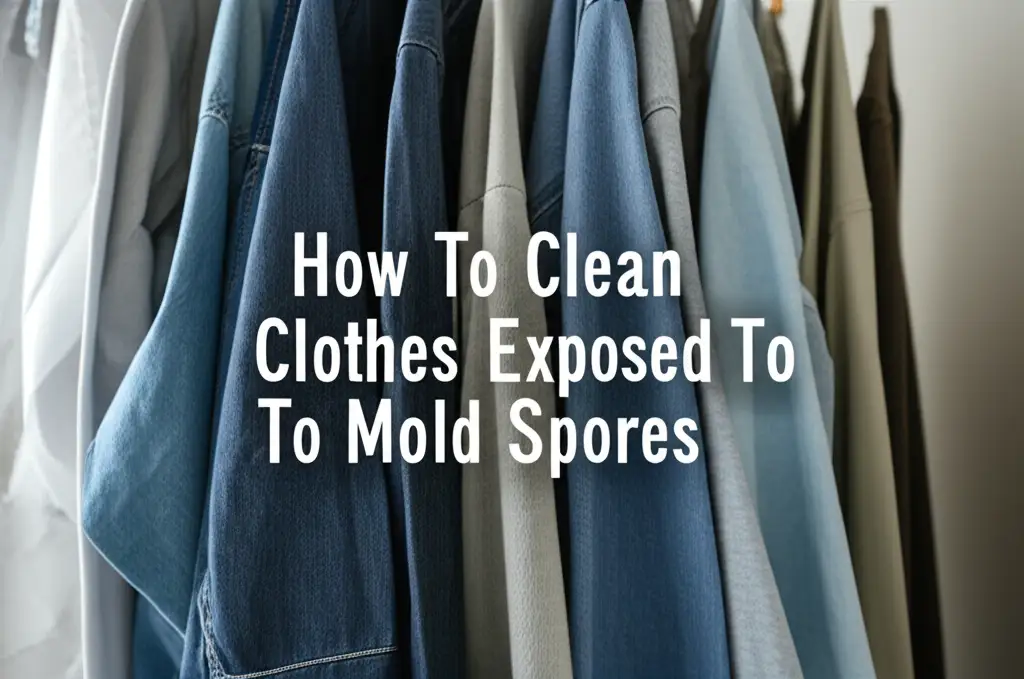· Home Cleaning · 14 min read
How To Clean Clothes Exposed To Mold Spores

Banishing Mold: How To Clean Clothes Exposed To Mold Spores
Finding mold on your favorite clothes can be a distressing sight. It often comes with an unpleasant musty smell and visible spots. You might worry that your garments are ruined forever. Mold, a type of fungi, thrives in damp, dark environments. Clothes left wet in a laundry basket or stored in a humid closet are prime targets for mold growth.
Knowing how to clean clothes exposed to mold spores is important for restoring your garments. It also helps protect your health. Mold can trigger allergies and respiratory issues in some people. This comprehensive guide provides step-by-step instructions. We will cover assessing the damage and preventing future mold outbreaks.
Takeaway:
- Isolate moldy clothes immediately to prevent mold spread.
- Pre-treat visible mold spots before washing.
- Use effective cleaning agents like borax, vinegar, or bleach for washing.
- Dry clothes completely, preferably in sunlight, to kill remaining spores.
- Practice good ventilation and proper storage to prevent future mold growth.
Cleaning clothes exposed to mold spores requires careful pre-treatment, washing with a mold-killing agent, and thorough drying. This process removes visible mold, eliminates musty odors, and destroys microscopic spores, making your garments safe to wear again.
First Steps: Assess and Isolate Moldy Garments
When you discover mold on clothes, your first action is crucial. Do not throw moldy clothes into your regular laundry pile. This can spread mold spores to other garments and even your washing machine. I always recommend handling moldy items separately to contain the problem.
Begin by taking the mold-affected clothes outdoors if possible. This prevents releasing spores into your indoor air. Shake off any loose, dry mold spots from the fabric. Wear gloves and a mask during this step for personal protection. This simple act reduces the amount of mold you bring inside for washing.
Safety First: Protecting Yourself
Protecting yourself is always the top priority when dealing with mold. Mold spores can irritate your lungs and skin. Some people experience allergic reactions or asthma attacks from mold exposure. I always wear protective gear before I start handling moldy items.
Use rubber gloves to avoid skin contact with mold. An N95 respirator mask helps prevent inhaling airborne mold spores. Eye protection, like safety goggles, also keeps spores from getting into your eyes. These precautions make sure you stay safe during the cleaning process. You are tackling the mold, but you should not become a victim of it.
Pre-Treatment Fundamentals
Pre-treating moldy areas is essential for effective removal. Simply washing clothes often does not get rid of all mold spores or stains. A good pre-treatment weakens the mold’s grip on the fabric. This makes it easier for the washing machine to finish the job.
You can use various substances for pre-treatment. A paste of baking soda and water works well for mild mold. For tougher spots, a diluted solution of borax or vinegar can penetrate the fabric. Apply the pre-treatment directly to the moldy areas. Let it sit for at least 30 minutes before washing. This gives the solution time to break down the mold.
Effective Laundry Solutions for Mold Removal
Using traditional laundry detergent alone often fails to eliminate mold spores. You need powerful cleaning agents that kill fungi. Several common household products work well for this purpose. Each has its own benefits and considerations depending on the fabric type. I find success by choosing the right agent for the job.
Borax is a natural mineral salt known for its mold-killing properties. Add half a cup of borax to your washing machine load along with your regular detergent. It acts as a fungicide and helps remove odors. Vinegar, a mild acid, also kills mold and eliminates musty smells. Baking soda is another excellent odor absorber and mild abrasive for scrubbing. Bleach is very effective but only safe for white, bleach-safe fabrics.
Using Bleach for White Fabrics
Bleach is a powerful disinfectant and mold killer. It is highly effective for white clothing and other bleach-safe items. However, bleach can damage colored fabrics. It can also weaken elastic and certain synthetic materials. Always check garment care labels before using bleach.
For white clothes, add about half a cup of liquid chlorine bleach to your washing machine’s bleach dispenser. Use the hottest water setting suitable for the fabric. Bleach works by oxidizing the mold, which destroys its structure. After washing, ensure the clothes are thoroughly rinsed to remove all bleach residue. I always run an extra rinse cycle to be safe.
Natural Alternatives: Vinegar and Baking Soda
For colored clothes or delicate fabrics, natural alternatives like vinegar and baking soda are excellent choices. They are gentler than bleach but still effective against mold. I often recommend these for a safer cleaning approach. Many people use a combination of these ingredients for various cleaning tasks around the home. Learn more about their power here: how to clean with vinegar and baking soda.
Add one to two cups of white vinegar to the wash cycle along with your detergent. The acetic acid in vinegar kills most mold species. For a pre-soak, mix one cup of vinegar with a gallon of water and soak the moldy clothes for an hour. Baking soda helps neutralize odors and provides a gentle scrubbing action. You can add half a cup of baking soda directly to the wash or make a paste for pre-treatment. Combining these two natural powerhouses can tackle many household cleaning challenges, not just laundry. For instance, they are very useful when you want to clean your dishwasher with vinegar and baking soda. They provide a safe, effective alternative to harsh chemicals.
Washing Mold-Affected Clothing: Techniques and Temperatures
Once you have pre-treated your moldy garments, they are ready for the washing machine. The right washing technique and water temperature are important for success. Hot water is generally best for killing mold spores. However, always check the fabric care label first. Using a temperature too high can damage certain materials.
Separate moldy clothes from non-moldy items for washing. Use the longest and hottest wash cycle recommended for the fabric. This ensures maximum contact time with the cleaning agents. A heavy-duty cycle with an extra rinse option is often ideal. This guarantees thorough cleaning and rinsing out of all mold debris and cleaning product residues.
Hot Water Versus Cold Water Effectiveness
Hot water is generally more effective at killing mold spores than cold water. Temperatures above 140°F (60°C) can kill most mold and mildew. This is why washing on the hottest setting suitable for the fabric is often recommended. High heat helps sanitize the clothes and remove lingering odors.
However, not all fabrics can withstand hot water. Delicate items, wool, silk, and some synthetics require cooler temperatures. For these materials, rely more on the pre-treatment and mold-killing additives like vinegar or borax. Cold water will still help rinse away spores and grime, but it may not fully sterilize the fabric. Always prioritize the garment’s care instructions to avoid damage.
Machine Washing Cycles and Soaking
Selecting the correct machine washing cycle is important. A “heavy duty” or “sanitary” cycle often provides the necessary agitation and wash time. These cycles are designed for heavily soiled items. They ensure the cleaning agents penetrate the fabric deeply. I typically choose the longest wash time available.
For very stubborn mold, an initial soak before the wash cycle can be beneficial. Fill a tub with hot water and add one cup of borax or two cups of vinegar. Submerge the moldy clothes and let them soak for several hours or even overnight. This extended contact time helps break down the mold further. After soaking, transfer the clothes to the washing machine with fresh cleaning agents.
Thorough Drying to Prevent Mold Re-growth
Drying clothes completely is arguably the most critical step in mold removal. If clothes remain even slightly damp, mold spores can quickly re-establish themselves. This negates all your cleaning efforts. Proper drying prevents future mold problems and eliminates any lingering musty smells. Never put damp moldy clothes back into a closet or drawer.
After washing, remove the clothes immediately from the washing machine. Do not let them sit in the drum, as this creates a damp environment perfect for mold. If possible, dry the clothes outdoors in direct sunlight. Sunlight acts as a natural disinfectant and mold killer. If outdoor drying is not an option, use a tumble dryer on the hottest setting suitable for the fabric.
Tumble Drying Versus Air Drying
Both tumble drying and air drying have their place in drying mold-affected clothes. Tumble drying on a high heat setting can effectively kill any remaining mold spores due to the sustained high temperature. Ensure the clothes are completely dry before removing them from the dryer. You might need to run an extra cycle if they feel even slightly damp.
Air drying outdoors in direct sunlight is often the best method. The sun’s UV rays are powerful mold killers. The fresh air also helps dissipate any lingering musty odors. Hang clothes individually to ensure good air circulation. If drying indoors, use a well-ventilated area with a fan or dehumidifier. Never air dry moldy clothes in a damp basement or unventilated room.
Checking for Residual Moisture and Odor
After drying, always perform a thorough check for any residual moisture or odor. Clothes should feel completely dry to the touch. Pay special attention to seams, pockets, and thicker areas of fabric. These spots can retain moisture. A simple sniff test also helps. If you detect any musty smell, the mold might not be fully gone.
If clothes are still damp or smell musty, repeat the entire cleaning process. Do not store or wear clothes that still have a moldy smell. Lingering odor indicates active mold spores or mold residue. Re-washing and re-drying will usually resolve this. Patience in this step ensures complete mold eradication and prevents recurrence.
Addressing Persistent Mold Odors and Stains
Sometimes, even after thorough cleaning and drying, a stubborn mold odor or stain remains. This can be frustrating, but it does not mean your garment is beyond hope. Persistent odors often indicate that some spores are still present or deeply embedded. Stains are mold pigments that have dyed the fabric. I have found several techniques that can tackle these tough issues.
One effective method is an extended soaking period. For colors, consider an oxygen-based bleach product, as it is gentler than chlorine bleach. You might also need a specialized enzyme cleaner. These cleaners break down organic matter, including mold residue. Always test any strong cleaning agent on an inconspicuous area first.
Soaking Methods for Stubborn Odors
For odors that just won’t quit, an overnight soak can work wonders. Fill a large tub or basin with hot water. Add one cup of white vinegar and half a cup of borax. Submerge the clothes completely, making sure they are fully saturated. Let them soak for at least 8 hours, or even up to 24 hours. The extended contact helps these agents penetrate deeply into the fibers.
After soaking, transfer the clothes directly to the washing machine. Wash them again using a regular cycle with your chosen mold-killing additive. This double-treatment often removes lingering smells. Sometimes, I add a cup of baking soda to the rinse cycle for an extra odor-neutralizing boost. This approach effectively tackles mold odors from various sources.
Enzyme Cleaners and Professional Cleaning
Enzyme cleaners are biological solutions that break down organic stains and odors. They contain special enzymes that target and digest proteins, starches, and fats found in mold and mildew. These cleaners are particularly useful for organic stains and musty smells. Apply the enzyme cleaner directly to the affected area. Let it sit for the recommended time before washing.
If all home remedies fail, professional cleaning might be your last resort. Dry cleaners have access to specialized equipment and chemicals. They can often remove mold and mildew that regular home washing cannot. Inform them clearly about the mold problem. This helps them choose the appropriate treatment. Professional cleaning is often worth the cost for valuable or sentimental items.
Preventing Future Mold Growth on Clothes
Preventing mold from growing on your clothes in the first place is far easier than removing it. Mold thrives in dampness and stagnant air. By controlling these factors, you can create an environment where mold cannot flourish. I always emphasize proactive measures to my clients. Simple changes to your laundry and storage habits make a big difference.
Ensure clothes are completely dry before putting them away. Improve air circulation in closets and drawers. Control humidity levels in your home. Regularly clean your washing machine to prevent mold buildup inside it. These steps create a hostile environment for mold spores.
Humidity Control in Your Home
High humidity is mold’s best friend. Mold spores need moisture to grow and spread. Maintaining proper humidity levels in your home is key to preventing mold on clothes and other surfaces. Aim for indoor humidity levels between 30% and 50%. You can monitor this with a hygrometer, an inexpensive device.
Use a dehumidifier in damp areas like basements, laundry rooms, or poorly ventilated closets. Ensure good ventilation throughout your home, especially after showering or cooking. Open windows when possible. Fix any leaks promptly. Reducing overall moisture in your living spaces directly impacts mold prevention on your garments.
Proper Storage Techniques
How you store your clothes directly affects their susceptibility to mold. Never put away damp or even slightly moist clothes. Always ensure garments are bone dry before folding or hanging them. This is the most basic rule of mold prevention. Storing damp clothes in a dark, enclosed space like a closet creates a perfect mold breeding ground.
Give your clothes room to breathe. Do not overpack closets or drawers. Air circulation around garments helps prevent moisture buildup. Use breathable garment bags for long-term storage instead of plastic ones. If storing clothes in boxes, use acid-free archival boxes. Add desiccant packets, like silica gel, to absorb excess moisture in storage containers or seasonal clothes boxes.
Immediate Washing of Damp Clothes
Do not let wet towels or sweaty gym clothes sit in a hamper for days. This is a common mistake that leads to mildew and mold. As soon as you take off damp clothes, either wash them immediately or hang them to air dry before placing them in the laundry hamper. This simple habit stops mold from ever taking root.
Even seemingly dry clothes can harbor enough moisture for mold if packed tightly. Air out clothes after wearing them, especially if they have absorbed body moisture. Regular and prompt laundry cycles for damp items are your best defense. This prevents musty smells from developing and keeps your clothes fresh and mold-free.
FAQ Section
Q1: Can moldy clothes be saved?
Yes, most moldy clothes can be saved with proper cleaning methods. Minor mold and mildew are often fully removable. Severe mold damage, where the fabric is extensively discolored or degraded, might be irreversible. Always try cleaning before discarding garments.
Q2: Is it safe to wash moldy clothes with regular laundry?
No, it is not safe to wash moldy clothes with regular laundry. Mold spores can transfer to other garments during the wash cycle. Always isolate and wash moldy items separately to prevent cross-contamination. Clean your washing machine afterward.
Q3: What kills mold on fabric naturally?
White vinegar and borax are natural and effective mold killers for fabric. Vinegar’s acetic acid breaks down mold, and borax acts as a fungicide. Baking soda helps neutralize odors and lightly scour mold. These natural options are gentle on most fabrics.
Q4: How do I get mold smell out of clothes after washing?
If mold smell persists after washing, repeat the cleaning process. An extended soak in a strong vinegar solution or a borax solution can help. Ensure clothes are completely dry after washing, preferably in direct sunlight. Sunlight naturally removes odors.
Q5: When should I throw away moldy clothes?
You should throw away moldy clothes if the mold growth is extensive and covers a large area. Also discard clothes if the fabric shows signs of degradation, like holes or significant weakening. If multiple cleaning attempts fail to remove the mold or smell, it is time to discard the item.
Q6: Can mold damage my washing machine?
Yes, mold can grow inside your washing machine, especially in the detergent dispenser, door gasket, or drum. This mold can then transfer to your laundry. Regularly clean your washing machine to prevent mold buildup. Run an empty hot cycle with vinegar or bleach occasionally.
Conclusion
Finding mold on your clothes can feel like a setback. However, with the right approach, you can effectively clean clothes exposed to mold spores. Remember to act quickly and carefully. Isolate affected garments to prevent spreading spores. Protect yourself with gloves and a mask during handling.
Pre-treat stains and odors with appropriate solutions like vinegar or borax. Wash clothes thoroughly using hot water suitable for the fabric. Always ensure clothes are completely dry before storing them. Sunlight is a powerful ally for final sanitization. Implement preventive measures like humidity control and proper storage to keep your wardrobe mold-free. Taking these steps not only saves your clothes but also helps maintain a healthier living environment.
- mold removal
- laundry care
- fabric cleaning
- mildew




